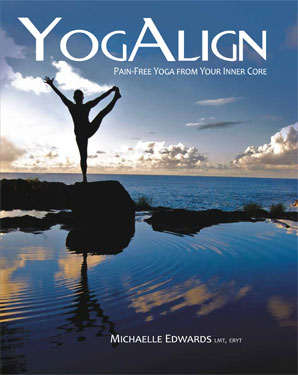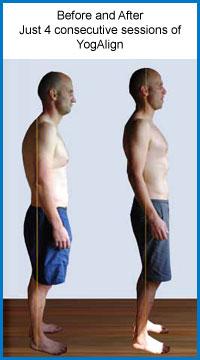
Note: elephantjournal.com received these review items for free, in return for a guarantee that we would review said offering. That said, we say what we want—good and bad, happy and sad.
“The YogAlign method works at the nervous system level, creating almost immediate transformation to a pain-free state of being in the body without effort.”
Quite a claim to live up to, I thought, but I was determined to keep an open mind because there’s value in learning something new. The title resonated with me, “pain-free yoga,” this piqued my interest right away because who wouldn’t want to be pain-free?
The YogAlign program, developed by Michealle Edwards, has been over 20 years in the making as a result of countless hours spent on her own mat and working as a movement therapist.
She incorporates her experiences as a massage therapist and yoga teacher, specializing in working with clients suffering from pain and misalignment to create a set of tools that anyone can utilize. A serious knee ligament injury had a huge impact on her yoga practice and this prompted her research into how some of the traditional yoga postures were causing more harm than good.
No scare tactics or infomercial pitches here but there are several case studies and before and after photos of personal clients. She began a serious investigation into how the body works as a whole and admits that what many of the techniques that she has developed “are the opposite of what [she] was originally taught to do in yoga and stretching classes-and for good reason.”
The YogAlign book contains over 300 pages worth of theory, anecdotes, an anatomical road map, illustrations and a practice DVD including a full-length yoga class and further explanation of the unique YogAlign system.
Edwards credits our poor posture and sedentary lifestyle as some of the underlying causes of losing our “innate kid body,” our lack of freedom in our movement and breathing processes. Her answer is to “re-pattern the neuromuscular wiring, enabling you to acquire optimal alignment on an innate and intrinsic level.”

YogAlign identifies the fascia, connective tissues of the body, as the true supportive foundational structure of our bodies. “Quality of our breath, our movements, our posture and even our moods are defined by the elasticity of our fascia.”
The analogy of an orange when it is peeled and the skin removed, continues to hold its shape because of the white cellulose holding the fruit intact, much like our fascia that determines our shape, structure and movement. This explanation helped me to visualize it and understand it in a different way. This is extremely helpful for yoga instructors, body workers and movement therapists are the illustrations included along with detailed explanation of the fascial lines of the body.
The illustrations are done by Thomas Myers, author of Anatomy Trains. These were an exceptional accompaniment to the side-by-side photo illustrations of YogAlign postures and explanations of each of the fascial lines throughout the body. This made it a valuable reference for me as a yoga instructor because I’d be able to have both the written and the visual resources to go back when I needed to.
What I noted as unique is that in the aptly named section, Yoga doesn’t have to hurt, the traditional yoga postures that put the body into a right-angle position are eliminated altogether and “not recommended in YogAlign because it restricts the internal movements of breathing and does not simulate how a human body moves in real life.”
Included are photo illustrations of how postures such as seated forward bend done traditionally makes no sense because it shortens the front of the body in order to stretch the back and “exacerbates alignment and pain issues” that already exist.
Instead, she offers modifications using the YogAlign principles that we need to honor our wisdom and respect the bodies we are in, including the natural spinal curves. Postures not recommended for safety reasons is a section found at the back of the book that restates the YogAlign philosophy that we should be able to breathe freely and be pain-free while practicing yoga.
The second half of the book is the method of YogAlign with each of the recommended postures fully explained and shown in great detail. There are notes and caution text boxes throughout providing additional information. It’s a well-organized resource and the full sequence of 70 plus postures of YogAlign can be found at the back of the book. This was helpful to me as I used it as an additional visual cue as I was being guided through the practice on the DVD.
The upside of having the book handy during practice was that I could pause the video and reference the alignment when needed.
The yoga practice was uncomplicated but there were a few things that made it unique such as the self-massage, some of the names of the poses were a bit different and the Core Sip Breath technique that was brand new to me. SIP stands for structurally informed posture.
I’d recommend viewing the Fascial anatomy and Core Breathing chapter on the video to learn the method before jumping into the practice. As explained in the practice section of the book, “by using the Core SIP breath, you create your own internal resistance mechanism, training the breathing muscles from the inside out.”
By reading and practicing YogAlign techniques, I’ve been reminded of several points: a ongoing investigation and understanding of our anatomy helps us practice more mindfully, efficiently and safely, taking a fresh look at our yoga practice with a beginner’s mind is beneficial and necessary in order to fine tune and modify it to suit our needs and serve our greater good and finally, the practice begins and ends with our breath.
Love elephant and want to go steady?
Sign up for our (curated) daily and weekly newsletters!
Editor: Catherine Monkman
Photos: Used with Permission from YogAlign/Michealle Edwards











Read 4 comments and reply